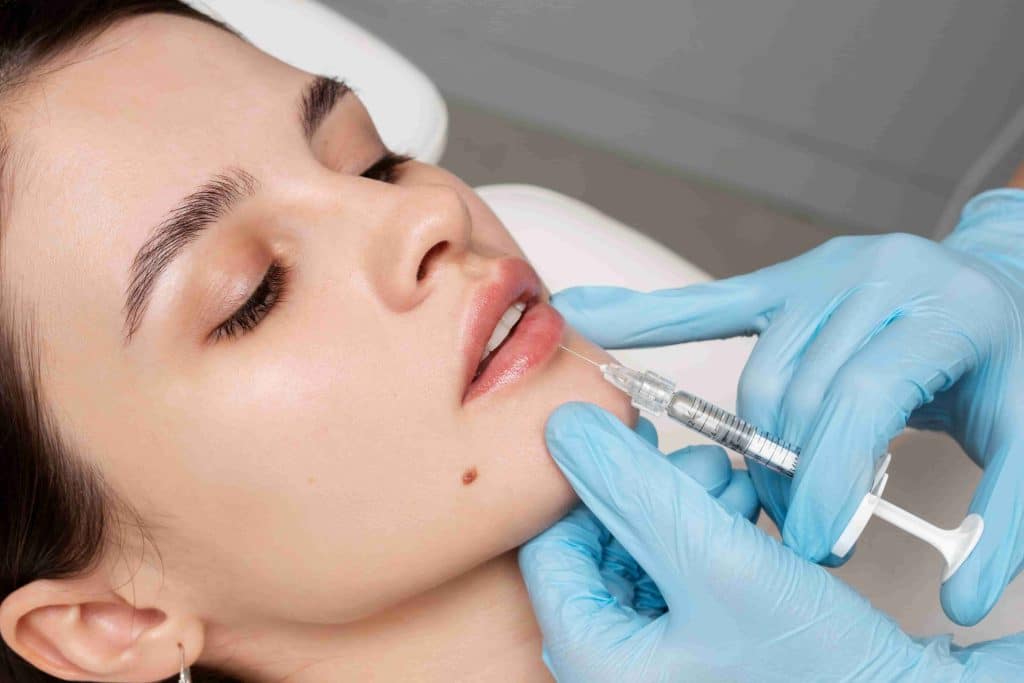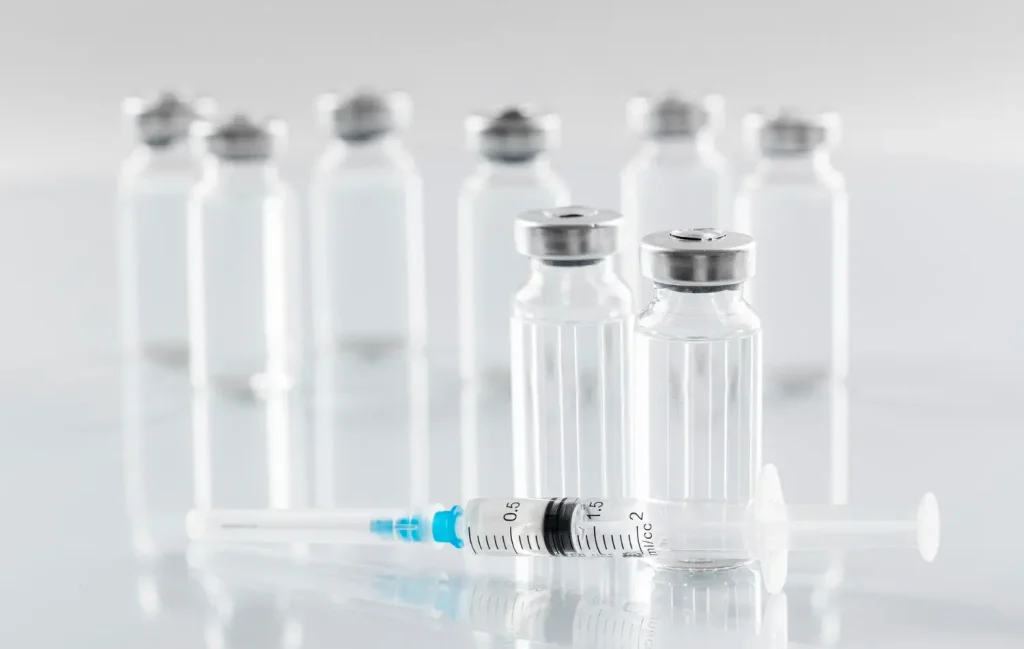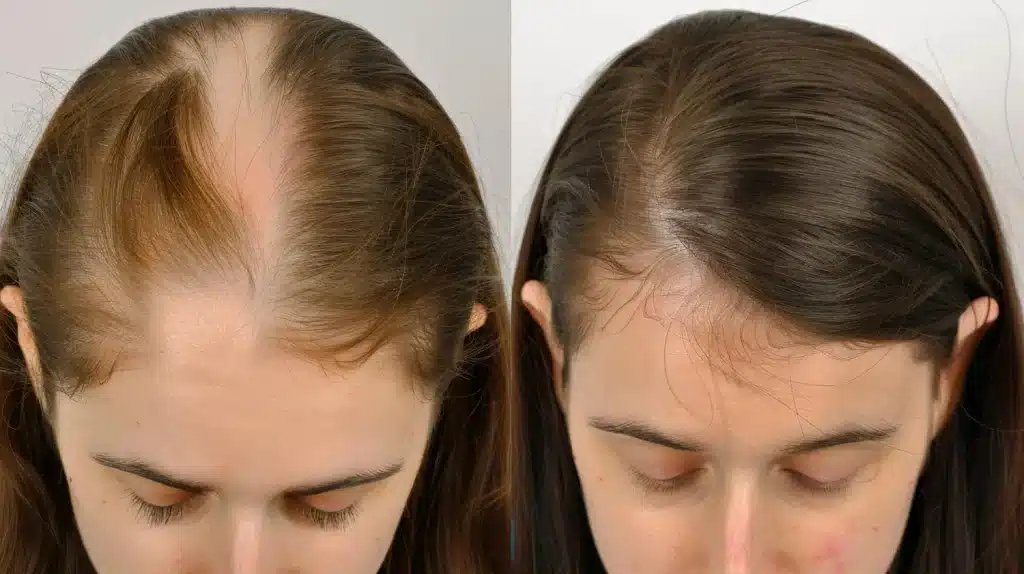Misconceptions about lip fillers have led to the unfortunate association with overfilled, unnatural-looking pouts commonly seen on popular influencers or reality TV stars. Therefore, it’s important to dispel these misconceptions and shed some light on how things really work.
When administered by a skilled professional who considers the harmony of your facial features, fillers can achieve a subtle and natural lip enhancement. It’s all about finding the balance and ensuring the results complement the overall appearance. This article addresses the issue of natural-looking lip augmentation and clarifies its potential when approached with expertise and aesthetic sensibility.
Lip Fillers Explained
There are different types of lip fillers available for lip augmentation.
- Hyaluronic Acid (HA) Fillers: Examples include Restylane, Juvéderm, Belotero, etc.
- Collagen-Based Fillers: Derived from human or animal sources but less commonly used today.
- Poly-L-Lactic Acid (PLLA) Fillers: Stimulate collagen production over time.
- Calcium Hydroxylapatite (CaHA) Fillers: Provide longer-lasting results.
- Autologous Fat Fillers: Use the patient’s fat cells harvested from another body area.
- Polymethyl Methacrylate (PMMA) Fillers: Contain microspheres that provide permanent volume.
The most popular fillers and the ones most suitable for achieving a natural-looking effect are those based on non-animal origin hyaluronic acid because they:
- Rarely cause allergies or complications;
- Can address complex aesthetic defects;
- Are fully compatible with tissues;
- Have an optimal biodegradation period (from 6 to 12 months).
Moreover, hyaluronic acid not only corrects the volume and size of the lips but also addresses age-related changes and congenital or cosmetic imperfections (disproportion, thin lips). It also promotes natural hydration and rejuvenation of the lips, triggering tissue regeneration processes and the production of necessary structural proteins for the formation of new cells.
The Problem of Artificial-Looking Lips
Cosmetically enhanced lips can look fake when certain factors are not carefully considered during the lip augmentation process. Here are some key elements of a fake or unnatural appearance:
- Excessive Volume
Overfilling the lips with too much filler can lead to an exaggerated and disproportionate appearance. Lips that appear overly plump and swollen are often associated with an artificial look.
- Lack of Proportion and Balance
Natural lips have a certain balance and proportion and balance between each other and also themselves and other facial features. The result can look artificial when these proportions are not respected during augmentation.
- Undefined Vermilion Border
The vermilion border is the distinct edge that separates the colored part of the lips from the surrounding skin. When this border is not well-defined or is excessively enhanced, it can create an unnatural and “drawn-on” appearance.
- Irregular Lip Shape
Lips with an irregular or asymmetrical shape can appear unnatural when artificially enhanced without addressing these underlying irregularities. Therefore, it is crucial to consider the individual’s natural lip shape and work with it to create a harmonious and balanced outcome.
- Unnatural Texture and Movement
Lips with unnatural texture or stiffness can be a telltale sign of cosmetically enhanced lips. Conversely, achieving natural texture and movement is crucial in ensuring that the lips blend seamlessly with the surrounding tissues.
- Overfilled Cupid’s Bow
Cupid’s bow refers to the double curve on the upper lip, creating the characteristic “M” shape. Overfilling this area can result in an exaggerated or unnatural appearance, especially if the curves are too pronounced or asymmetrical.
- Poor-Quality Fillers
Using low-quality or inappropriate fillers is one of the easiest ways to botch up the procedure and get an unnatural look.
What Do Natural Lip Fillers Look Like?
Natural lip fillers aim to enhance the appearance of the lips while maintaining a natural-looking and subtle result. The outcome may vary depending on various factors such as the patient’s anatomy, the desired effect, and the skill of the healthcare professional administering the filler. Natural lip fillers should provide a balanced and harmonious augmentation, improving lip volume, definition, and symmetry.
As a result, the lips may appear fuller, plumper, and more hydrated, with improved contour and smoothness. The goal is to achieve natural-looking lips complementing the patient’s facial features and avoid an exaggerated and fake-looking appearance. A skilled practitioner will carefully consider the patient’s unique lip structure and proportions in order to create aesthetically pleasing results that align with their wishes.
Ways To Get Natural Lip Fillers
There are several ways to ensure a natural-looking result when using lip filler treatments. Here are some things to keep in mind:
- Use Hyaluronic Acid Fillers
Opt for FDA-approved hyaluronic acid-based dermal fillers, such as Restylane or Juvéderm. These fillers provide natural-looking results by adding volume and enhancing lip shape. In addition, the hyaluronic acid molecules attract and retain moisture, resulting in plump and hydrated lips.
- Opt for Gradual Volume Enhancement
Consider a gradual approach to lip augmentation, spreading the treatment across multiple sessions. This will allow for subtle lip filler enhancements and a more natural progression, ensuring the results complement your facial features harmoniously.
- Choose a Proven Specialist
The chosen specialist needs to be highly competent, have good lip anatomy knowledge, extensive experience in this field, and use the appropriate products.
What to consider when choosing a specialist?
- Appropriate medical education;
- Current or at least previous work in a large, well-known cosmetology center or clinic;
- Certificates of training on the exact products that will be used for natural lip injections;
- Numerous confirmed positive customer reviews.
- Go for Proportional Lip Enhancement
Rather than focusing solely on volume, emphasize lip proportions to achieve a balanced and natural appearance. This involves considering factors such as the relationship between the upper and lower lips, vermilion border definition, and overall facial symmetry.
- Get a Personalized Treatment Plan
Collaborate with a doctor on ideas toward a customized treatment plan best suited to the unique goals and facial features. As part of this, a comprehensive assessment will be conducted, taking into consideration the patient’s lip structure, skin condition, and desired visual outcome. It ensures the most natural lip filler technique is chosen to achieve natural-looking results, aligned with expectations.
How to Prevent Overfilled Lips
It’s easy to get carried away and overdo lip filler treatments. Here are some ways to avoid unfavorable outcomes:
- Gradual Volume Enhancement
Instead of filling lips to the maximum at the first appointment, it is better to have a series of lip filler treatments – with a small amount of filler injected each time until you the desired volume is achieved.
- Individualized Filler Selection
Restylane, for example, is great for adding defined contour to the lips, while Juvéderm is usually used to focus on plumpness. The lip filler injected must be thin and pliable so that everything looks as natural as possible. Again, an experienced professional will select the type of filler to achieve the best result.
- Attention to Lip Proportion
Another thing to keep in mind for lip fillers to be natural is proportions. To be beautiful yet look natural, the upper lip should be smaller than the lower one, and the ratio of upper to lower lips must be 1:1.6 (Kar M, 2018). If the upper and lower lips are the same fullness, or if this ratio is off by too much, the lips may look overfilled. During the treatment, the injector should consider the proportion between the upper and lower lips, the vermilion border, and the overall facial symmetry of the patient.
- Respect for Lip Anatomy
Respecting the natural lip anatomy is crucial. Overfilling or injecting in problematic areas can lead to an unnatural appearance. The doctor should comprehensively understand lip anatomy to ensure precise and strategic filler injections.
Conclusion
It is crucial to dispel the misconceptions surrounding lip fillers and shed light on their potential in achieving natural and subtle lip enhancements. When administered by a skilled professional that considers the harmony of facial features, lip fillers can create a balanced and harmonious augmentation that improves lip volume, definition, and symmetry.
Natural lip fillers aim to enhance the appearance of the lips while maintaining subtle and natural-looking results. People can achieve such outcomes by opting for FDA-approved hyaluronic acid fillers, considering a gradual approach to volume enhancement, choosing a proven specialist, emphasizing proper lip proportions, and using a personalized treatment plan.
FAQ
What lip filler looks the most natural?
Hyaluronic acid fillers, such as Restylane and Juvéderm, tend to provide the most natural-looking lip injection results for lip enhancement because their gel-like consistency closely resembles the natural texture and softness of the lips.
Is it possible for lip fillers to look natural?
Yes, lip fillers can look natural when performed by a skilled and experienced medical professional. Lip fillers, particularly those made with hyaluronic acid, can be carefully injected to enhance lip volume, improve lip shape and symmetry, and define the lip borders while maintaining a natural appearance.
Will 1ml lip filler look natural?
The naturalness largely depends on the individual’s lip anatomy and desired outcome. In many cases, 1ml of lip filler can provide subtle lip injection enhancement and a natural-looking result, but much will depend on the unique characteristics of each patient.
References
Kar M, Muluk NB, Bafaqeeh SA, Cingi C. Is it possible to define the ideal lips? Acta Otorhinolaryngol Ital. 2018;38(1):67-72. doi:10.14639/0392-100X-1511





















